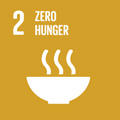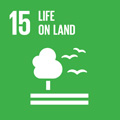- Docente: Luciano Cavani
- Credits: 6
- SSD: AGR/13
- Language: Italian
- Teaching Mode: Traditional lectures
- Campus: Bologna
- Corso: First cycle degree programme (L) in Land and Agro-Forestry Technologies (cod. 5831)
-
from Sep 16, 2024 to Dec 05, 2024
Learning outcomes
The course aims to provide Graduates the knowledge necessary for the qualitative and quantitative management of the flows of the main elements in the soil-water-plant-atmosphere system. Particular attention will be paid to the description of the processes that characterize the cycles of carbon, nitrogen, phosphorus, potassium and sulfur, examining the aspects relating to both ecosystem balance and plant nutrition. The teacher will focus on the distinctive aspects of cycles in forestry and agricultural environments. Notes will be made on the particularities of soils intended for industrial use or in any case strongly influenced by anthropic activities. In this context, notes will be provided relating to the dynamics of the main pollutants, both inorganic and organic, to the processes of adsorption, degradation, translocation in soils. A specific space will be dedicated to the processes that preside over the sequestration of carbon in the soil, addressing in depth the various chemical, biochemical and physical mechanisms that lead to the stabilization of carbon in the various soil aggregates (macro-meso- and micro-aggregates). We will focus on the factors of natural and/or anthropogenic origin that influence the turnover of organic carbon in the soil, linking the knowledge to some issues such as climate change and the different methods of soil management.
Course contents
PREREQUISITES: The student knows the basics of mathematics, chemistry, physics, plant science (botany) and soil science (pedology). These prerequisites are provided by the basic courses delivered during the first year of the course. It is advisable to pass the aforementioned training activities before taking the final exam.
PROGRAM: the course addresses the most relevant conceptual aspects for understanding the cycles of the main elements in agricultural and forestry systems. The course starts from the origin of the elements that constitute matter and then takes into consideration the molecules that constitute the building blocks of living organisms (biomolecules). At this point we have all the elements to deal with the distribution and flows of elements in agro- ecosystems. The course focuses on the carbon, nitrogen and phosphorus cycles (primarily), also taking into consideration the main environmental crises that involve these cycles.
This course integrates and completes the SOIL CHEMISTRY course (module held by Prof. Claudio Marzadori), the latter provides the student the knowledge necessary to understand the distribution and flows of elements in the soil, as key component of agricultural systems and forestry.
UNIT 1 - INTRODUCTION TO BIOGEOCHEMISTRY AND BIOMOLECULES (12 HOURS)
1.1 What is biogeochemistry? Origin of the elements. The inorganic and organic constituents of living beings.
1.2 Biomolecules: carbohydrates, nitrogenous compounds (amino acids and proteins), lipids, phenolic compounds.
1.3 Enzymatic reactions and cellular metabolism. Energetic aspects of enzymatic reactions. Mechanisms and kinetics of enzymatic reactions.
Knowledge acquired in teaching unit 1:
- knowledge of theories on the origin of elements;
- basic knowledge on the chemical structure, classification and main types of biomolecules;
- knowledge of the mechanisms of enzymatic reactions.
UNIT 2 - THE BIOGEOCHEMICAL CARBON CYCLE (8 HOURS)
2.1 The carbon cycle in agro-forestry systems. Chlorophyll photosynthesis (water use efficiency, nutrient use efficiency). Breathing.
2.2 Net primary production (NPP). Net ecosystem production (NEP). Global estimate of NPP and biomass. Fate of the NPP (the debris cycle). NPP and “global change”. Soil organic matter and "global change".
Knowledge acquired in teaching unit 2:
- knowledge of the main processes underlying photosynthesis;
- knowledge of the metabolic pathways underlying energy production in plants;
- knowledge of net primary production and net ecosystem production.
UNIT 3 - BIOGEOCHEMICAL CYCLES IN AGRO-FORESTRY SYSTEMS (16 HOURS)
3.1 Introduction to terrestrial biogeochemical cycles. Biogeochemical cycles in forest systems and herbaceous systems.
3.2 The cycle of nitrogen, phosphorus, sulfur and potassium in agro-forestry systems.
3.3 Notes on the impact of man on terrestrial biogeochemical cycles. The critical zone. Acid rain. Nitrogen saturation. The increase in carbon dioxide and global warming. Contaminating elements in agro-forestry systems.
Knowledge acquired in teaching unit 3:
- basic knowledge of terrestrial biogeochemical cycles;
- basic knowledge of the dynamics of nitrogen, phosphorus, sulfur and potassium within agro-forestry systems;
- knowledge of the main impacts of human activities on the biogeochemical cycles of elements in agro-forestry systems.
UNIT 4 - EXERCISES (24 HOURS)
Classroom and laboratory exercises will be carried out on:
- separation of plant pigments by thin layer chromatography;
- photosynthesis: an assay using leaf discs;
- the mass balance in agro-forestry systems;
- calculation of the efficiency of nutrient use in agro-forestry systems;
- use of models in calculating soil carbon stock.
At the end of the exercise unit, students are invited to write a short report. The content of the report can represent an examination topic.
Readings/Bibliography
In addition to the material distributed by the teacher and made available online and lecture notes, it is advisable to study the topics covered on:
- AA.VV. (2016). Fondamenti di Biochimica Agraria - Pinton R., Cocucci M., Nannipieri P., Trevisan M. (Coord.), Pàtron Editore, Bologna.
- AA.VV. (2017). Fondamenti di Chimica del Suolo - Sequi P., Ciavatta C., Miano T. (Coord.), Pàtron Editore, Bologna.
- Schlesinger W.H. & Bernhardt E.S. (2020). Biogeochemistry. An analysis of global change. 4th ed. Academic Press, London.
Recommended readings to complete the study of the subject:
- Egan D. (2023). The Devil's Element: Phosphorus and a World Out of Balance. W. W. Norton & Company.
- Boccaletti G. (2022). Water. A biography. Knopf Doubleday Publishing Group.
- Vaillant J. (2023). Fire weather. A true story from a hotter world. Alfred A. Knopf.
Teaching methods
The course is divided into two parts:
FRONTAL TEACHING: through the administration of the teaching units in the classroom, the student acquires the necessary knowledge to understand the chemical, biochemical and microbial processes that underlie biogeochemical cycles in agro-forestry systems. The acquisition of knowledge and the ability to understand will be constantly monitored, during the lectures, through a continuous interaction between teacher and students. The interaction between teacher and student, an activity that will materialize in the request of the teacher to discuss topics covered in the teaching also according to their impact on topical issues inherent to the discipline taught, will also have the purpose of promoting interest, the development of autonomy of judgment and to improve communication skills;
EXERCISES: the student participates in didactic and seminar experiences that aim to provide analytical parameters useful for the prediction and interpretation of the physical, chemical and biological processes that characterize the biogeochemistry of the elements in agro-forestry systems. This part of the teaching will also have the objective of verifying the ability to apply the acquired knowledge. In consideration of the type of activity and teaching methods adopted, the attendance of this training activity requires the prior participation of all students in the training modules 1 and 2 on safety in the study places, [https: //elearning-sicurezza.unibo .it /] in e-learning mode and the participation in Module 3 of specific training on safety and health in places of study. Information on dates and methods of attendance of Module 3 can be consulted in the specific section of the degree program website.
Assessment methods
Verification of learning of the teaching of BIOGEOCHIMICA DEGLI ELEMENTI NEI SISTEMI AGRO-FORESTALI - Integrated course of CHIMICA E BIOCHIMICA DELL'AMBIENTE AGRO-FORESTALE, takes place through a final interview, which can also be taken in English (students wishing to take the examination in English are allowed), conducted jointly with the verification of module 2 (CHIMICA DEL SUOLO). The interview will focus on the topics covered in class in the two courses and will usually be asked 2 basic questions, one for each thematic area (chimica del suolo, biogeochimica degli elementi nei sistemi agro-forestali). Starting from this structure, we will proceed to the appropriate investigations relating to the topics addressed. The verification must be passed in a global way and it is necessary that the candidate reaches the mark of 18 out of thirty in each of the 2 disciplinary areas characterizing this integrated course. The commission will evaluate the scores achieved in each of the two disciplinary areas and by making a weighted average of the scores, according to the CFU dedicated to each area (6 CFU Chimica del suolo, 6 CFU Biogeochimica degli elementi nei sistemi agro-forestali), will come to formulate the overall assessment. The duration of the oral exam will be approximately 30 minutes.
The verbalizing teacher is Prof. Luciano Cavani.
Teaching tools
For frontal teaching, video projectors, video tutorials and films will be used.
Laboratory exercises will be held in:
- laboratory of Chemistry, Agricultural Biochemistry and Food Technology
- laboratory of ICT and multimedia
Office hours
See the website of Luciano Cavani
SDGs



This teaching activity contributes to the achievement of the Sustainable Development Goals of the UN 2030 Agenda.
